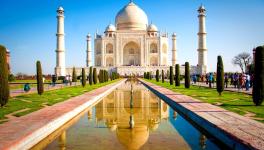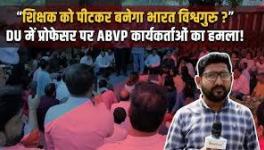Only Mass Movements Can Fight Hindutva, Not Electoral Alliances

Image Courtesy: Truth of Gujarat. Dalits of Sarangpur pledge to never dispose off dead cattle and come to Una on Aug 15 in huge numbers.
The ongoing debate on what the left should do in India today is framed in different ways. For some, the point of the debate is how to defend the rights of the people against attacks by the Hindutva forces, and the need for all-in-unity. For others, the point is fighting the Hindutva forces, but along with advancing a more transformative agenda of economic and social change; in other words, the challenge of fighting a dual struggle.
I would argue that these differences need to be perceived in terms somewhat different from arguments about terminology in contexts from the past. Let us look at two other questions instead, and shift the debate to the question of a single as opposed to a dual struggle. I would argue that the differences over tactics call for a re-examination of how we should understand the right today. And not just in India, concerned as we are with the present critical juncture at home; but also the global context of the growth of the right.
Post 1991, with globalisation – globalisation of capital, to be precise – we have seen large sections of people left behind, while a tiny minority has gained enormous wealth. The global inequalities between the elite and the rest have grown sharply across the world, be it in advanced countries such as the US or the UK, or in emerging economies such as India, Brazil and South Africa.
Today, the top 10 corporations of the world have more wealth than 180 of the “poorest” countries combined. Among the top 100 economic entities, 69 are corporations and 31 sovereign countries. The corporations have never been as powerful as they are today.
With the rise of the power of global corporations, the economic space of nation states has been restricted; the ability of nation states to provide “relief” to the people has, correspondingly, declined. This crisis of the nation state has fuelled the rise of the right – from Donald Trump to Modi, from Erdogan to Duterte, we see various expressions of a deep crisis of politics.
Political forces, whether they ascribe to liberal democracy, social democracy, the revolutionary left, or the national movements that came into power after the anti-colonial struggles, perceive the state as an instrument for economic development and redistribution. In post-colonial countries, such a perception gave rise to what has been described as the developmentalist state. In all countries, public goods and other welfare measures have been seen as the essential preserve of the state. It is the neoliberal phase of capitalism that has destroyed this developmentalist or redistributive role. What remains with the state is, for the most part, is a package of repressive functions – as performed by the police and the military establishment. As far as the economy is concerned, the state can, at best, provide a “fair” marketplace through regulation; everything else left to the god of the market. This is the mantra of the neoliberal phase of capitalism.
The onslaught on the nation state by neoliberal capital has led to the rise of the new right. Forces decisively defeated in the independence struggle of most countries are back. The forces of ethnic, religious and racial nationalism, all different guises of exclusionary nationalism, are rearing their heads, but in new forms; they are arguing for “national” identities against the onslaught of globalising forces, but on the basis of different kinds of exclusionary ideology. It is this growth of the new right that fosters the rise of a Trump or Brexit in countries where the elite have led the globalisation drive, leaving large sections of the people behind. It is this new right that has helped white nationalism regain its appeal in Europe and the US. It is this new right, again, that is the reason for the Islamic and Hindutva forces gaining ground in South Asia.
These forces of the right focus on exclusionary identities in defining the nation. Muslims and Christians cannot be a part of a “nationalist” India. Nor can Hindus in a nationalist Pakistan. Or Mexicans in the US. The fight against globalisation becomes framed only in terms of these identities, leaving out the fight against global capital. A Trump or a Modi is completely comfortable with global capital and with serving its interests.
It is not an accident that globalisation has come hand in hand with ethnic and religious divisions. It is no accident, either, that the neo-colonial US, and the old colonial powers, have always identified the left and nationalist forces in colonies and former colonies as their enemies, while aligning with forces of identity based nationalisms and “fundamentalist” forces. Genuine anti-colonial struggles were built on attempts to create independent economic space for their countries, not just national identities. This was anathema to the imperial powers. The CIA supported attempts by the Muslim Brotherhood to assassinate Nasser in Egypt in the 50's, and the Brotherhood's insurrection in 1982 against Hafez al Assad in Hama, Syria. This also explains the west's alliance with a Wahhabi Saudi Arabia and its agenda of regime change in the largely secular countries of West Asia.
Arguing that we need to fight this extreme form of exclusionary nationalism emerging in different countries -- a nationalism that endangers everything we stand for -- is, of course, stating the obvious. It is also clear that we need to build a broad-based unity to fight these forces. What needs to be discussed and debated is whether the political agenda of fighting proto-fascist or semi-fascist forces – forces of exclusionary nationalism – can be divorced from the economic context giving rise to these forces.
Again, India is not alone in this debate. In country after country, the left is debating ways to combat a resurgent right. But unless we understand what is moving the people to the right, we will not be able to challenge this shift.
In times of globalisation, the consensus among bourgeois parties has been that every country needs to open up to global capital; that the state must withdraw from the economy. The right, with its white nationalism or ethnic/religious nationalism, thus emerges as the “national” opposition to globalisation. The Labour party, for instance, is abandoning the welfare state and the workers with the emergence of UKIP and the far right in the UK. With the Congress giving up economic nationalism in India, the BJP has laid claim to the nationalist space, supposedly upholding “Indian culture”, and its brand of cultural nationalism.
There is a trend to call for support of the lesser of two evils – a kind of theory of “lesser of the two evilism”. Maggie Thatcher is evil, support Blair’s Labour. Trump is evil, support a Hilary Clinton. If Taliban poses threat to Pakistan, support the US in its drone war there. This policy of supporting the lesser of two evils shifts the entire polity to the right. We have seen this with the Labour Party in the UK. In India too, at a time when communal forces are on the rise, the Congress response has been to inch rightward and try a soft communal approach. Supporting the lesser evil does not stop such a shift to the right.
If the discontent of globalisation is the potent fuel feeding the new right, any strategy that does not address this vital link will not succeed. Even if we build a coalition that defeats the right in a particular election, it will not stop the rightward shift of polity.
This is why a dual strategy is important. It recognises that there are two axes along which struggles have to be organised. One axis is against the different forms of exclusions that neo-fascist forces are pursuing. The other axis is against the onslaught of globalising capital against the working people.
Yes, we need a strategy that can unite the broadest sections of the people when attacks are directed at what they can say or wrote, wear or eat, or the gods they can worship or not worship. But we also need movements – and new movements in the making that are emerging because of the large scale attacks on citizens’ rights, be they dalits, Adivasis, minorities, women, or working people. Indeed, the BJP and the Hindutva forces today attack everyone who reject their concept of an exclusionary India based on a Hindu identity. We need to rally all sections of the people in ongoing and new movements to defend the people and the democratic values in the constitution. We need to join all such struggles and create new platforms that are open to all sections and forces, including parties, popular movements, civil society groups, cultural figures and public intellectuals. The recent writers and scientists protests after the Dadri murder of Akhlaq are instances of such broad based struggles.
The left also needs to be at the forefront of struggles against the attacks on the working people of globalising capital. It must also recognise that casualisation of labour and changes in the countryside pose new challenges in organising workers, landless labour and the small peasantry. The hard-won rights of the working class are today sought to be taken away. In the name of development, forest dwellers and peasantry are losing their lands. Education and health are being privatised. Global capital is being invited with promises of even more concessions, if only they “make in India”. A strategic alliance is being forged between the Modi government and the US. This is the second axis of struggle.
Without this second axis of struggle, the Hindutva forces would paint the struggle between the “nationalist” BJP and a pro-western elite, talking about an “alien” concept of secularism. No relation to the freedom movement in which the RSS was conspicuous by its absence, or the anti imperialist struggles of today. This is why Modi flies umpteen times to the US to see his “friend” Barak, but has no time for the NAM summit taking place in Venezuela right now.
The two axes of struggle cannot be delinked, or perceived as either-or struggles for the left. Together, they define the left. If we are to defeat Hindutva politics, one struggle cannot be subsumed by the other; the dual struggle needs to be fought.
On the issue of dual struggles, we also need to remember the difference between movements and electoral politics. While movements bring about unity between sections and groups, and add to each other’s strength, elections are essentially competitive in nature. The political agenda – what each party stands for – becomes much more important. Electoral alliances need to have a programmatic unity, while movements can and should be much more broad based.
This is where the left has learned a costly lesson. If it unites in electoral platforms with political forces who support the neoliberal globalisation agenda, it dilutes its politics and weakens itself. A weaker left opens the way for the right.
So what should the left do in states where it is weak, or at the national level where it is not in a position to challenge state power? Those who argue for all-in-unity against the BJP, want the left to join ally with all forces, including the Congress. A section of the left also believes in this position, as this has been articulated in different fora.
Any electoral alliance has to have a programmatic basis; and it is difficult to see what programmatic link exists between the Congress policies of the last 25 years and the left. If the rise of the right is linked to the neoliberal economic policies, allying with these same forces will only play into the hands of the right. It will also cede the “nationalist” space to the fraudulent cultural nationalism of the BJP.
Does this mean maintaining equidistance between the BJP and other bourgeois formations that oppose Hindutva forces? No. The left does and must make a distinction between the Hindutva forces threatening the secular fabric of this country, and others including the Congress. Defeating the BJP in various states and at the national level is a key task today. This is not the disagreement within the left. The disagreement is over translating this understanding into electoral alliances with forces – specifically the Congress – with whom a programmatic understanding is not possible.
The discussions over electoral alliances distract from the key task facing all of us today – building mass movements to stop the rise of the right. In the ultimate analysis, only mass movements can stop the rise of fascism, not electoral politics. This is where the left needs to act: it needs to build such movements to oppose the divisive politics of the Hindutva forces, as well as its economic assault on the working people. This is the dual strategy that is at the heart of the left’s agenda of resistance.
Disclaimer: The views expressed here are the author's personal views, and do not necessarily represent the views of Newsclick
Get the latest reports & analysis with people's perspective on Protests, movements & deep analytical videos, discussions of the current affairs in your Telegram app. Subscribe to NewsClick's Telegram channel & get Real-Time updates on stories, as they get published on our website.
























